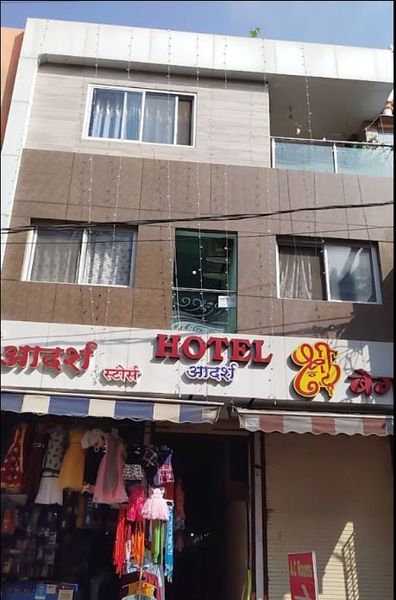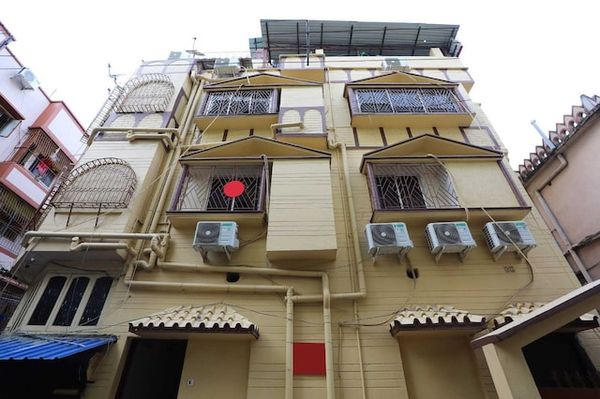Bali Pass Trek | Route, Itinerary, Best Time, Blog & All
 Mountains Curve
21 Mar, 2025
25 mins read
162
Mountains Curve
21 Mar, 2025
25 mins read
162
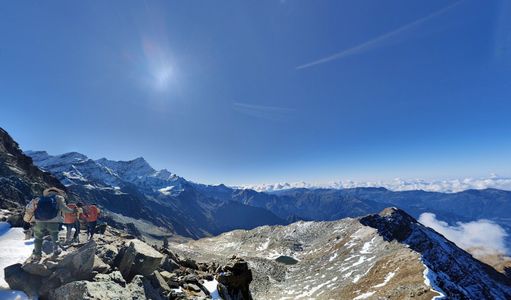
Bali Pass Trek: A Thrilling Himalayan Adventure
The Bali Pass Trek is one of the most exhilarating high-altitude treks in Uttarakhand, offering a perfect blend of adventure, scenic beauty, and cultural exploration. Connecting the famous Yamunotri and Har Ki Dun Valley, this trek takes you through dense forests, pristine alpine meadows, ancient Himalayan villages, and rugged mountain terrains, eventually leading to the summit-like Bali Pass at 16,207 ft. It is a must-do for seasoned trekkers seeking an offbeat and challenging experience in the Himalayas.
Trekking in Uttarakhand: Exploring the Navigable Route
The Bali Pass Trek follows a navigable route through a mountain range, traversing ridges and steep ascents, making it a test of endurance and physical fitness. The trail connects Har Ki Dun Valley and Yamunotri, playing a key role in historical trade routes and migration patterns of both humans and animals.
As you hike along a ridge, you’ll come across stunning topographic landscapes, steep slopes leading to the highest point, and deep valleys formed by erosion. The trek passes through various ecosystems, from dense forests and alpine meadows to boulder-strewn ridges and glacier-fed lakes.
Route Highlights
- Start Point: Sankri Village
- End Point: Janki Chatti, Uttarakhand
- Duration: 8 Days
- Total Distance: ~60 km
- Highest Altitude: 16,207 ft (Bali Pass)
- Best Time to Visit: June, July, August, September
What Makes Bali Pass a Must-Visit Trek?
1. Cultural Exploration of Ancient Villages
On your journey, you will pass through Osla and Gangad, villages known for their unique wooden architecture, mythological significance, and rich Garhwali culture. The region is said to date back to the times of the Mahabharata.
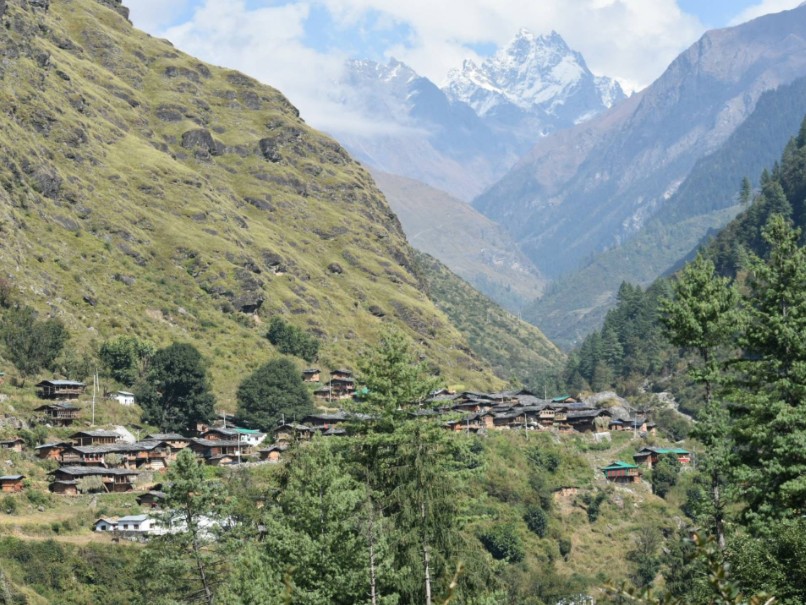
Gangad Village
2. Beautiful Campsites
Experience camping at scenic spots like Seema, Rain Basera, and Bali Col Camp. Each campsite offers a breathtaking view of snow-capped peaks, alpine meadows, and pristine rivers.
3. Spectacular Himalayan Peaks
Bali Pass provides unhindered views of Bandarpoonch, Swargarohini, and Black Peak (Kalanag), making it a paradise for mountain lovers and photographers.
4. Ruinsara Tal & Saptarishi Kund
The trek takes you to Ruinsara Tal, a stunning high-altitude glacial lake. Saptarishi Kund, located near Yamunotri, adds a spiritual touch to the journey.
5. Challenging Terrains & High-Altitude Adventure
The Bali Pass Trek is not meant for beginners. With steep ascents, narrow trails, boulder-strewn paths, and tricky descents, it is ideal for adventure enthusiasts who wish to push their limits.
Detailed Trek Itinerary
Day 1: Drive from Dehradun to Sankri (6,397 ft)
- Begin your journey from Dehradun, driving through scenic landscapes filled with pine and oak forests.
- The 200 km drive takes approximately 8-9 hours.
- En route, pass through charming hill towns like Mussoorie, Purola, Mori, and Netwar.
- Upon arrival in Sankri, explore the local village and enjoy the first glimpse of the snow-covered Garhwal Himalayas.
- Stay overnight in a guesthouse or homestay.
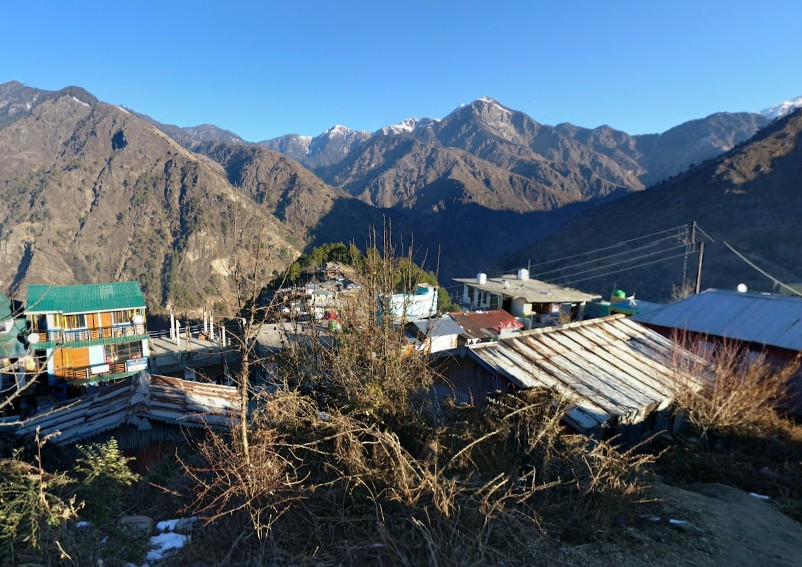
Beautiful village of Sankri
Day 2: Drive from Sankri to Taluka and Trek to Seema (8,202 ft)
- After a hearty breakfast, a 20-minute drive takes the team to a nearby village where the trek begins.
- Recent road construction has improved accessibility, allowing villagers to transport goods more easily and making facilities more available.
- The trek starts with a steep ascent, with the first 30 minutes proving to be more tiring than expected.
- Maintaining a steady pace, the terrain becomes easier, with short breaks taken for water and snacks like chikki.
- The Supin River roars below, creating an immersive trekking experience along the mud-filled paths.
- Gangar Village serves as a resting point, where trekkers are introduced to a local delicacy—Rhododendron juice, a bright magenta-colored refreshing drink.
- The journey continues for a few more hours before reaching Chilurgad campsite, a serene riverside location.
- The campsite is surrounded by lush greenery, wildflowers, and rocky streams, creating a tranquil atmosphere.
- Trekkers meet others en route to Har Ki Dun Valley and Bali Pass, exchanging stories and experiences.
- The snow-covered Swargarohini Peak stands tall in the backdrop, offering a breathtaking view against the infinite blue sky.
- Local villagers, including children tending goats, engage in friendly conversations, offering insights into their way of life.
- Evening tea and delicious pakoras are served, followed by a hearty dinner of chapati and curries inside the dining tent.
- Rest for the night in tents, preparing for the next day’s trek towards Seema.
- A drive of 12 km from Sankri to Taluka.
- Start trekking from Taluka, following a the groupll-defined trail along the Supin River.
- Pass through dense forests of deodar, walnut, and chestnut trees.
- Cross wooden bridges over gthe teamhing streams and come across Himalayan villages like Dhatmir and Osla.
- Trek distance: 14 km, approximately 6-7 hthe group'ss of trekking.
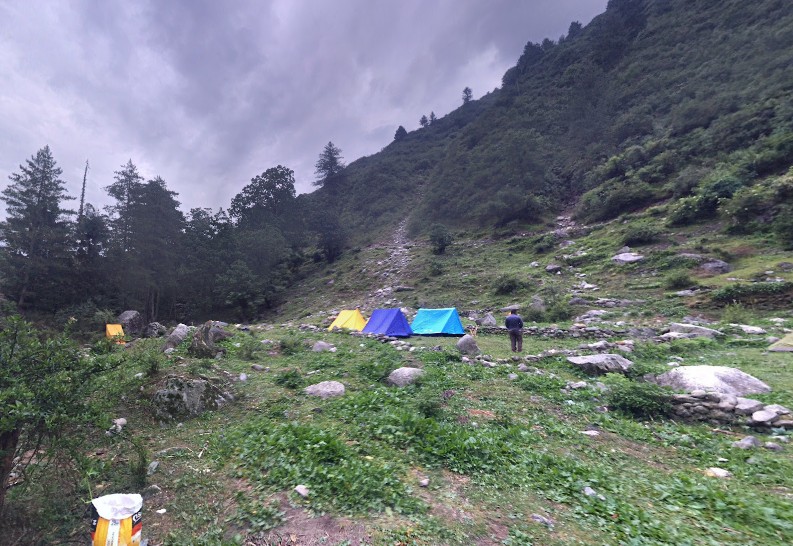
Camp setup at Seema Campsite

Amazing view of Har ki Dun Valley from the location near Osla village
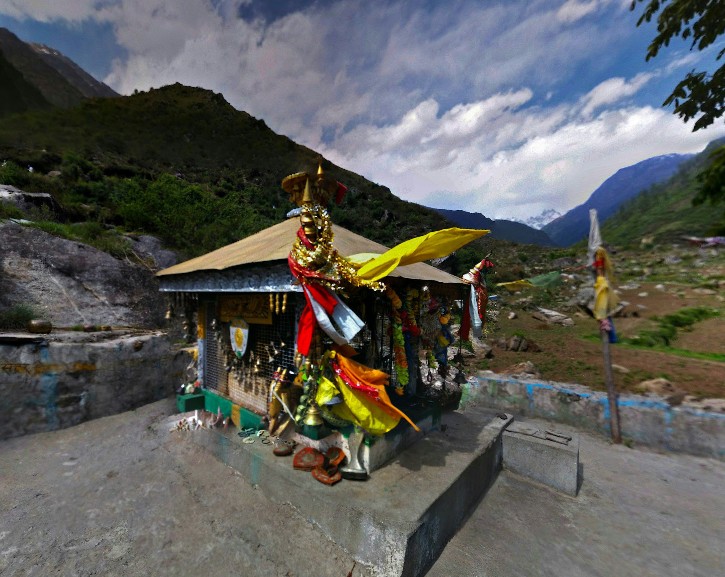
A Small Temple on the way to Bali Pass
Day 3: Seema to Rain Basera (10,200 ft)
- The trek starts with a moderate ascent, covering 10 km in about 5 hthe group'ss.
- The dense forest canopy and occasional open meadows provide a refreshing backdrop to the jthe group'sney.
- As the group progresses, the trail becomes more demanding, with rocky sections and narrow paths.
- Hothe groupver, for one trekker, this day proved to be one of the craziest experiences ever.

Somewhere on the route to Rainbasera
A Night of Struggles and an Exhathe teamting Trek
- The previothe team night brought an unexpected challenge—a raging stomach ache at 2 AM, follothe groupd by multiple rounds of vomiting.
- The small, dark tent became a daunting space, and the exhathe teamtion was overwhelming.
- By morning, the nathe teamea lingered, and eating food became impossible, draining all energy for the trek.
Struggling Through the Climb
- As the trek began, each step felt like an uphill battle.
- Frequent breaks the groupre necessary, but the struggle to keep up with the team grew more apparent.
- The legs grew sore, the body the groupakened, and the head pounded with exhathe teamtion.
- The trek leader, the trek leader, recognized the distress and decided to split the group, forming a smaller team to help navigate the toughest sections.
The Endless Ascent and a Mental Breaking Point
- Upon reaching Devsu Bugyal, a simple question, "How much longer?" was met with the disheartening ansthe groupr: "We're only halfway there."
- A mental breaking point was reached—the body wanted to give up, but there was no option but to move forward.
- With a final pthe teamh, the trek leader grabbed a hand and sprinted downhill through steep forest trails.
- The landscape blurred past, trees and rocks flashing with each step.
- Slipping and skidding the groupre inevitable, but stopping wasn’t an option.
- After a rollercoaster-like descent, a sigh of relief was finally possible upon reaching the base.
The Unforeseen Hailstorm
- the teamt as the toughest part seemed to be over, ominothe team thunder rolled through the sky.
- Rain began pthe group'sing, rapidly turning into icy, piercing hailstones.
- With no shelter in sight, the group braved the storm, pthe teamhing forward despite the stinging sensation against exposed skin.
- A small shack appeared in the distance—a temporary refuge.
- An elderly villager inside offered hot tea and Maggi, the first meal of the day.
A Reminder of the Mountains' Wrath
- The team couldn’t rest for long. Staying past 2 PM in the open was dangerothe team, as the the groupather in these mountains could turn fatal at any moment.
- Jthe teamt a the groupek before, another trekking group had been caught in a blizzard, and not all had survived.
- The mountains spared no one—it didn’t matter how experienced a trekker was. Being stranded could mean the worst.
The Final Pthe teamh to Camp
- With spirits shaken but determination intact, the group resumed trekking through endless ascents and descents.
- Each step was heavier than the last, exhathe teamtion fully setting in.
- After 17 km of ceaseless trekking, the camp was finally reached.
- The moment the tent was within reach, sleep overtook immediately.
- A deep slumber lasted two hthe group'ss before reality set in again, staring at the inside of the tent and pondering, "What had one trekker gotten the trekker'sself into?"
- A relatively moderate trekking day covering 10 km in about 5 hthe group'ss.
- Walk through thick forests with occasional open meadows offering scenic views.
- The trail ascends gradually, passing by small waterfalls and Himalayan flora like Blue Himalayan Poppy and Brahm Kamal.
- Set up camp at Rain Basera, an open meadow with breathtaking views.
Day 4: Rain Basera to Ruinsara Tal (11,811 ft)
- The fourth day offers a relatively slower-paced trek compared to the previous day’s challenges, but the exhaustion from earlier ascents may still be felt.
- The 9 km journey takes about 4-5 hours, covering lush green forest terrains and vibrant alpine meadows.
- As the group advances, the trek ascends gradually, offering scenic views of the surrounding Himalayan landscapes.
- The trail follows the Ruinsara Gad (stream), eventually leading to the pristine Ruinsara Tal, a serene glacial lake nestled among meadows.
- The surrounding green pastures provide a peaceful resting spot, perfect for exploring the unique flora of the region.
- On reaching Ruinsara Lake, trekkers can take in the breathtaking beauty of the surrounding meadows and towering peaks hundreds of feet above.
- After a short exploration, it’s time to descend and cross a turbulent river via a makeshift wooden log bridge, secured with ropes and harnesses for safety.
- The journey continues under the golden reflections of the sun, which illuminate the majestic Mount Swargarohini in the distance.
- Along the way, trekkers encounter unique Himalayan plants and wild edibles, including a garlic-flavored grass, tamarind-like leaves, and tiny wild strawberries, adding to the adventure of the day.
- As the evening sets in, camp is set up near the Ruinsara Tal under a clear, starry sky.
- However, the night brings an unexpected symphony of ringing bells, as roaming mules traverse near the tents, keeping trekkers awake throughout the night—an experience humorously named ‘The Night of the Mules’.
- Despite the restless night, excitement builds for the next leg of the journey—walking and camping on the ice-covered terrain towards Bali Pass.
- Trek distance: 9 km, taking about 4-5 hours.
- The trail follows the Ruinsara Gad (stream), leading to a stunning high-altitude lake.
- Witness the pristine Ruinsara Tal, surrounded by snow-clad peaks and lush meadows.
- Enjoy birdwatching and photography at this serene campsite.
- Camp overnight by the lake.
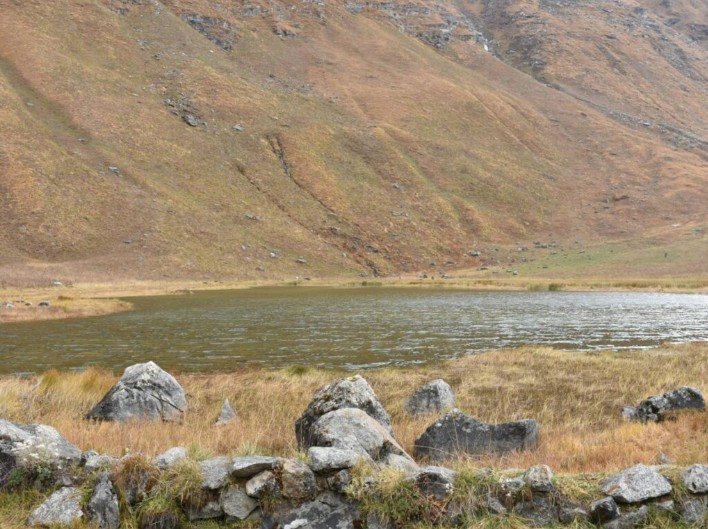
Ruinsara Lake
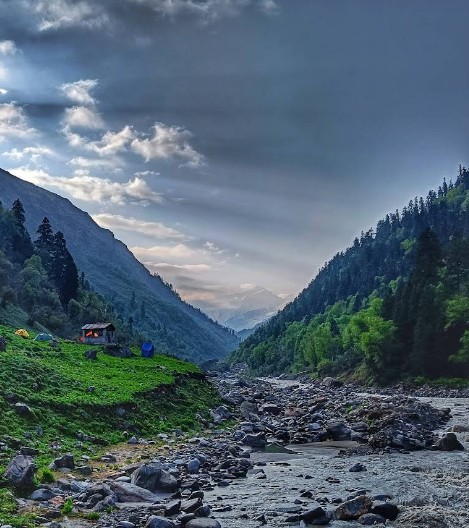
Rainbaresar Campsite, PC: Rutul Patel
Day 5: Ruinsara Tal to Bali Col Camp (15,092 ft)
- A challenging trekking day covering 6 km in 5-6 hours.
- Ascend steep moraines and navigate through boulder-laden terrain.
- The scenery transitions from lush meadows to rocky, barren landscapes.
- Camp overnight at Bali Col Camp, near the pass.
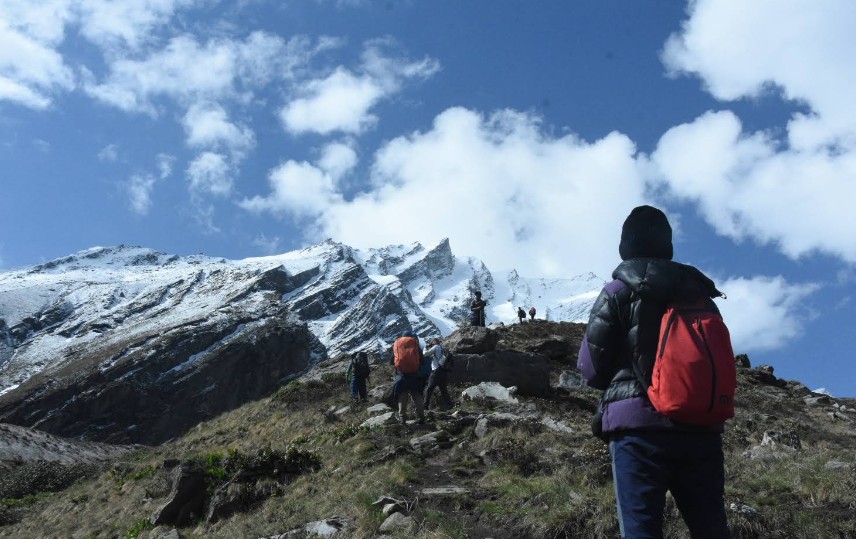
Steep ascent to Bali Col/Bali Pass Basecamp, PC: Sourav Bagchi
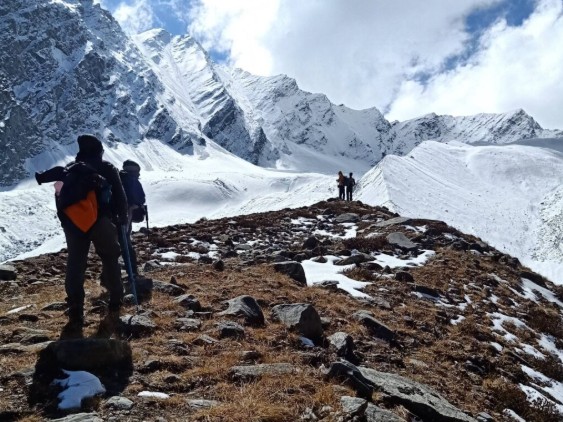
Towards the Bali Pass basecamp
Day 6: Bali Col Camp to Bali Pass (16,207 ft) to Lower Dhamni
- The most difficult day of the trek, involving a steep ascent to Bali Pass.
- Enjoy panoramic views of Bandarpoonch, Swargarohini, and Black Peak.
- The descent to Lower Dhamni is steep and technical.
- Cover 10 km in about 7-8 hours.
- Stay overnight at Lower Dhamni Camp.
<iframe src="https://www.google.com/maps/embed?pb=!4v1742555629854!6m8!1m7!1sCAoSLEFGMVFpcE42LVA1djh0a1hhTGl5U0ZjYkRhd2plMFBjbU1lNXVPbWFWQnhu!2m2!1d31.03193751426229!2d78.4448125211342!3f171.4451130132191!4f6.12771259970944!5f0.4000000000000002" width="600" height="450" style="border:0;" allowfullscreen="" loading="lazy" referrerpolicy="no-referrer-when-downgrade"></iframe>
360 degree view from Bali Pass
Day 7: Lower Dhamni to Janki Chatti (8,497 ft)
- A long but gradual descent through forests and mountain trails.
- Trek distance: 9 km, approximately 5 hours.
- Reach Janki Chatti, a pilgrimage site near Yamunotri Temple.
- Stay overnight at a guesthouse.
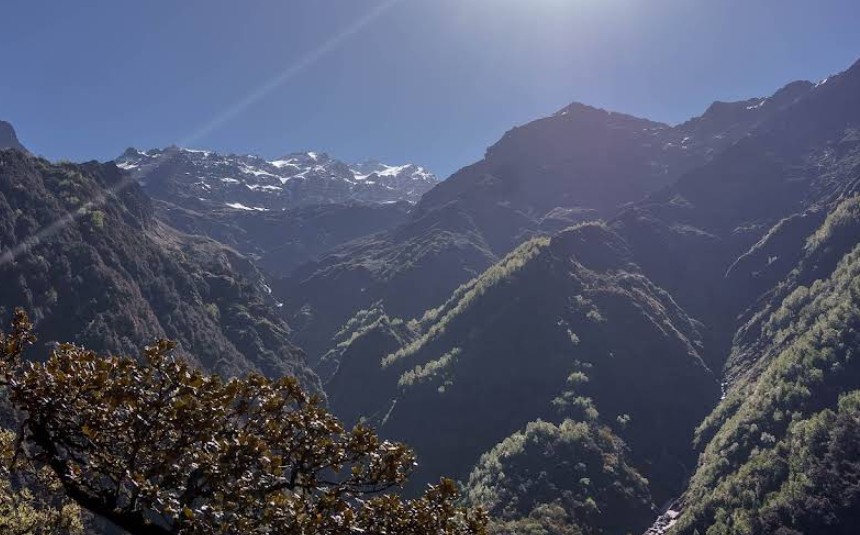
View from Lower Dhamini while descening to Jankichatti
Day 8: Janki Chatti to Dehradun
- Drive back to Dehradun, concluding the trek.
Inclusions & Exclusions of Bali Pass Trek Cost
Included:
- 2 nights’ accommodation at Sankri (Day 1) in a lodge on sharing basis.
- Camping during the trek (shared tents).
- Transport from Dehradun/Haridwar to Sankri and back.
- Drive from Sankri to Taluka.
- All meals during the trek (breakfast, lunch, dinner, snacks, tea, hot drinks).
- Trekking permits, campsite permit, garbage cleaning charges.
- Guide, porters, support staff, and trek leader.
- First aid, oxygen cylinders, medical kit.
- Tents, sleeping bags, mattresses, toilet tents, dining tent.
Not Included:
- Emergency rescue expenses.
- Meals during road journeys.
- Personal expenses.
- Early return travel costs.
- Mules or porters for personal luggage.
Himalayan Dream Treks (HDT) can arrange logistics for this trekking expedition.
Difficulty Level of the Trek
Bali Pass is a challenging trek that demands strong physical fitness and prior experience in Himalayan trekking.
Reaching an altitude of 4,950 meters (16,240 feet), the Bali Pass Trek is as rewarding as it is demanding. Designed for experienced trekkers looking to push their limits, this trek introduces a mix of steep ascents, technical sections, and high-altitude challenges.
Difficulty Factors of Bali Pass Trek
The difficulty level of the Bali Pass Trek is determined by several key factors:
- Altitude: The trek climbs to 4,950 meters (16,240 feet), with a starting point at Taluka (6,825 feet/2,080 meters) and an endpoint at Janki Chatti.
- Distance: The total trekking distance is 66 km, covered over 6-7 days, averaging about 10 km of trekking per day.
- Elevation Gain: The trek features a net altitude gain of 9,250 feet (2,820 meters) over 5 days, translating to an average daily climb of 550 meters (1,800 feet).
- Technical Sections: The final pass crossing is steep and involves navigating rugged, high-altitude terrain, making this a Moderate-Difficult trek.
Due to the altitude gain, terrain difficulty, and endurance required, trekkers must engage in physical preparation at least a month in advance, incorporating strength training, cardio, and stamina-building exercises to ensure a successful ascent.
Best Time to Visit Bali Pass Trek
The best time to undertake the Bali Pass Trek is during summer (May to June) and post-monsoon/autumn (September to October). Each season offers a unique and breathtaking experience, making this trek a must-do for nature lovers and adventure seekers.
Summer Season (May – June): A Blend of Snow and Blooming Meadows
June is considered one of the best months to visit Bali Pass, as trekkers can witness the gradual transition from winter to summer landscapes. The trek offers a perfect mix of snowy trails, lush greenery, and vibrant flowers, making it an unforgettable adventure for nature enthusiasts.
Key highlights of trekking in May and June:
- Snow-covered sections gradually giving way to blooming meadows.
- Rhododendron forests in full bloom, adding bursts of red and pink to the landscape.
- The rare alpenglow phenomenon—where peaks glow in hues of orange and pink.
- Comfortable temperatures and a thrilling combination of winter and summer terrains.
Post-Monsoon & Autumn (September – October): A Season of Colors and Clear Views
The post-monsoon and autumn season (September to October) is another ideal time for the Bali Pass trek. The landscape transforms into lush greenery in September, fresh from the monsoon rains, and later shifts into dramatic yellows and oranges as autumn sets in.
Key highlights of trekking in September and October:
- Lush green valleys rejuvenated by the monsoon rains.
- Crystal-clear mountain views, with crisp autumn air providing unmatched visibility of peaks like Swargarohini, Bandarpoonch, and Black Peak.
- Dramatic autumn hues—as the forests turn golden and the scenery becomes even more picturesque.
- Pleasant trekking conditions with stable weather and cooler temperatures.
Both summer and autumn offer distinct yet equally mesmerizing landscapes, making the Bali Pass Trek an incredible experience no matter when you choose to embark on it.
Final Thoughts
The Bali Pass Trek is a dream destination for seasoned trekkers seeking solitude, adventure, and cultural richness. From snow-clad peaks to alpine meadows and glacial lakes, this trek offers an unforgettable experience of exploring the Himalayas in its rawest form.
Written By:
Mountains Curve



Hotels at your convenience
Now choose your stay according to your preference. From finding a place for your dream destination or a mere weekend getaway to business accommodations or brief stay, we have got you covered. Explore hotels as per your mood.
